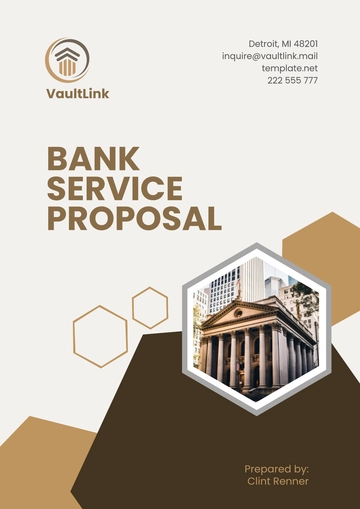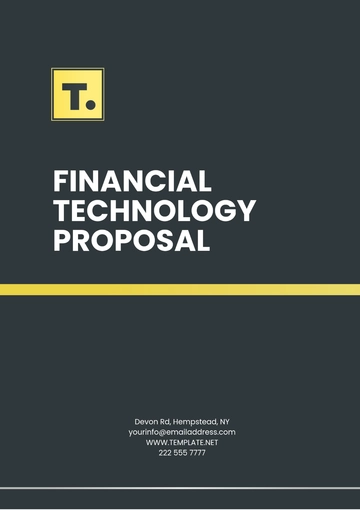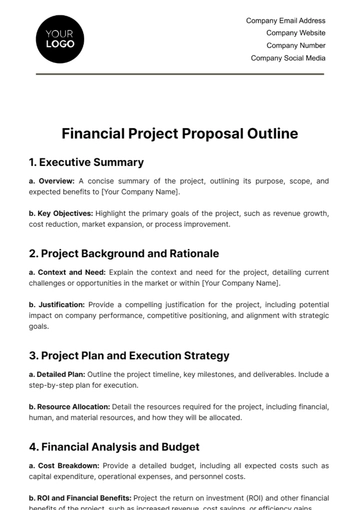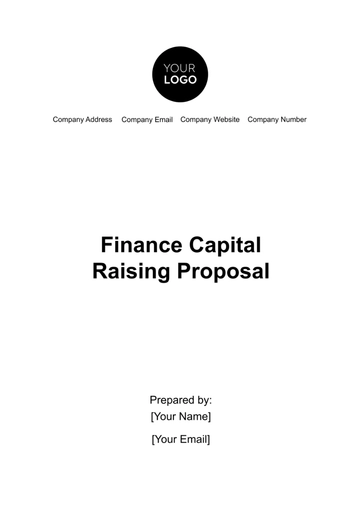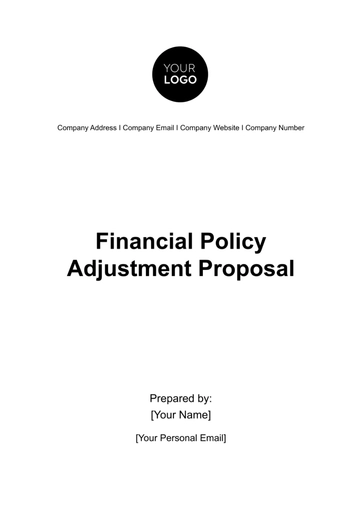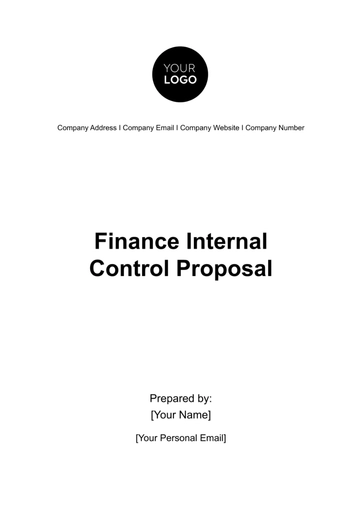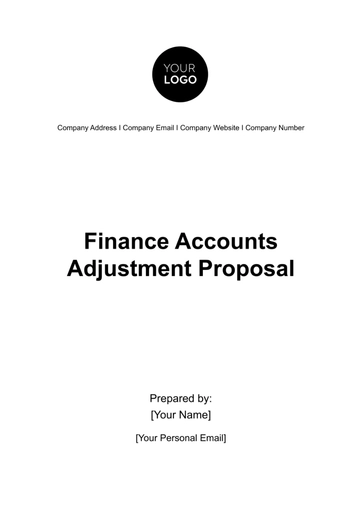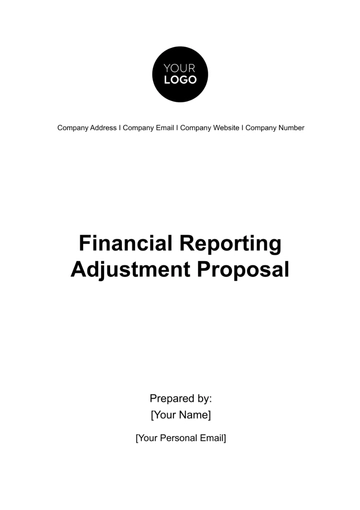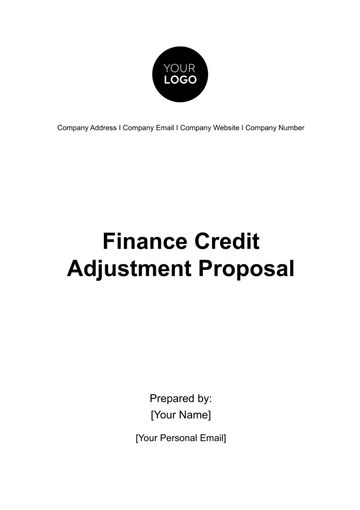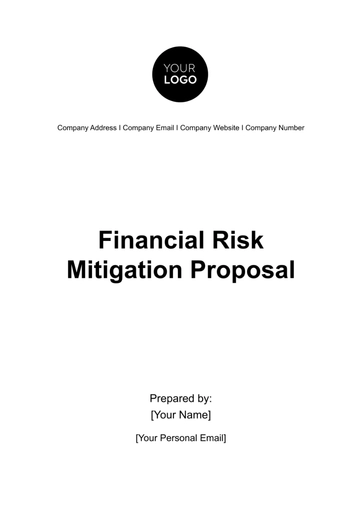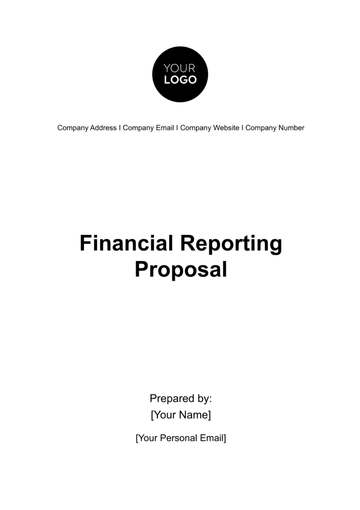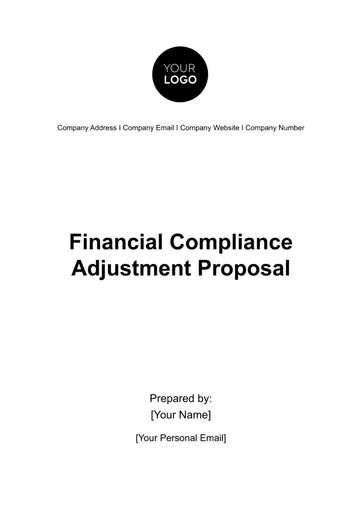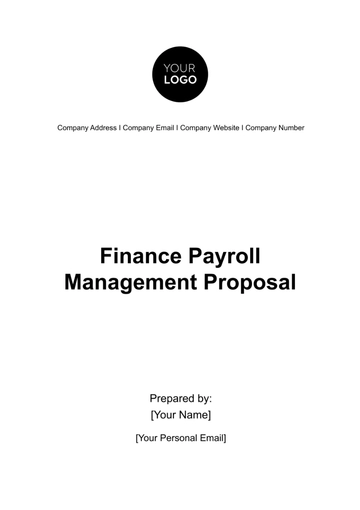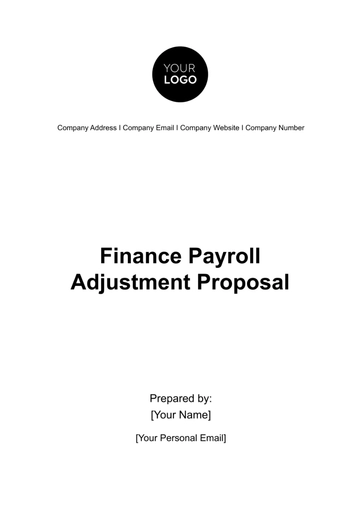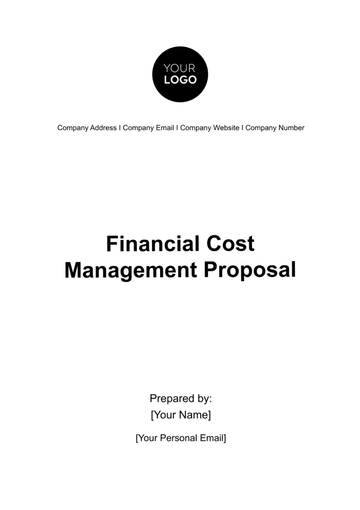Free Financial Policy Adjustment Proposal
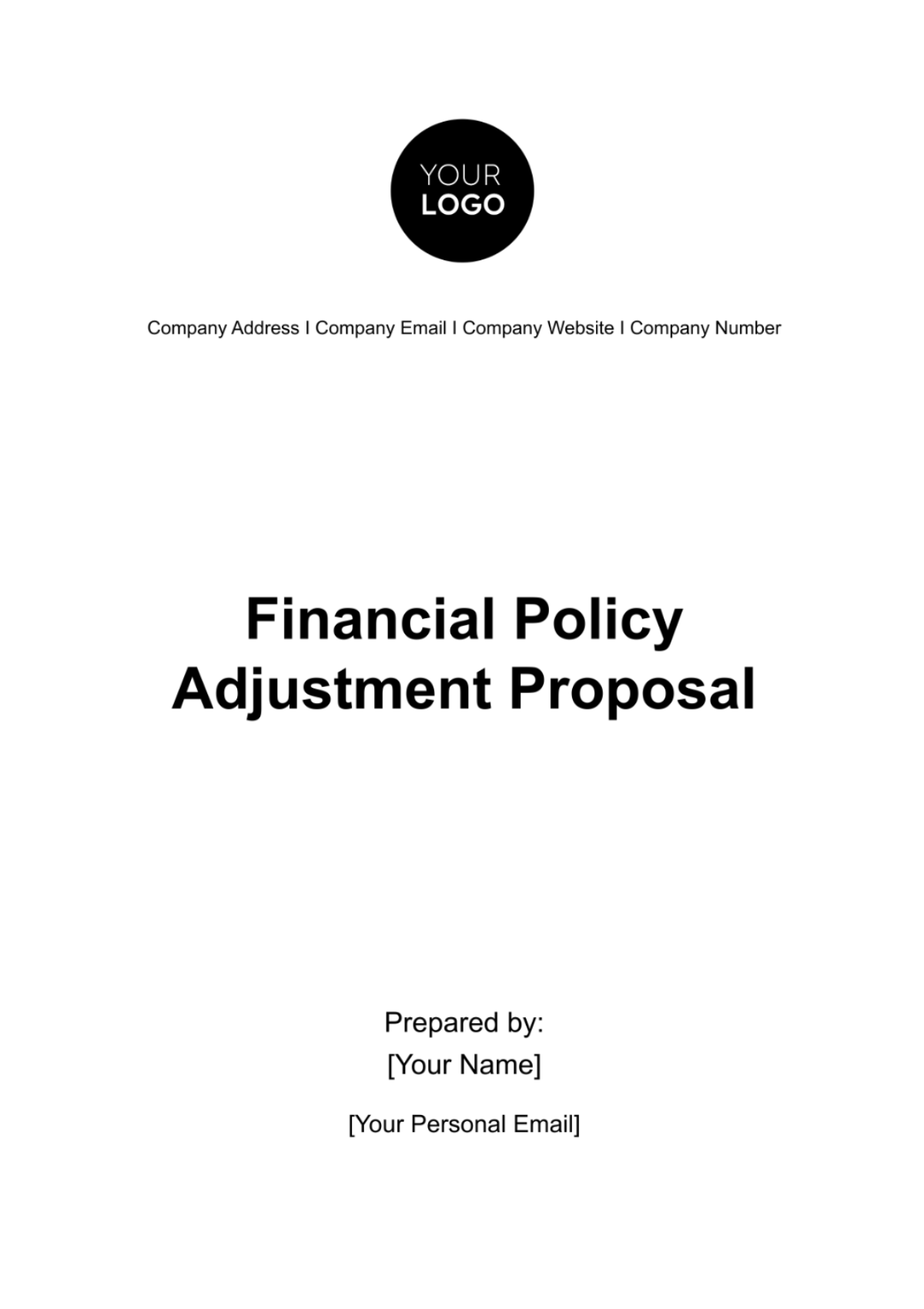
Executive Summary
A. [Your Company Name] Overview
[Your Company Name], a pioneering technology solutions provider, stands at the forefront of innovation in software development and IT services. With a rich history dating back to [year of establishment], we have consistently delivered cutting-edge solutions to clients globally.
In FY [2050], [Your Company Name] achieved remarkable financial success, recording a total revenue of [$100 million] and a net profit of [$25 million]. Our dedication to excellence, client satisfaction, and a talented workforce has positioned us as a leader in the industry.
However, recognizing the rapidly evolving business landscape and the need for proactive measures, [Your Company Name] is committed to refining its financial strategies. This proposal signifies our proactive approach to adapt to market dynamics, ensure financial sustainability, and maintain our competitive edge.
Objectives of the Proposal
A. Enhancing Financial Stability
At the core of this proposal is the commitment to enhancing [Your Company Name]'s financial stability. We aim to achieve this by strategically adjusting our financial policies to optimize revenue streams and streamline expense management. By doing so, we seek to fortify our financial position, ensuring resilience in the face of market uncertainties and economic fluctuations.
B. Ensuring Compliance
In an era of evolving regulatory frameworks, [Your Company Name] places a paramount emphasis on ensuring compliance with industry standards and legal requirements. This proposal underscores our dedication to aligning our financial policies with the latest regulations. By doing so, we aim to enhance transparency, accountability, and overall corporate governance.
As part of our commitment to excellence, [Your Company Name] acknowledges the significance of staying abreast of changing compliance landscapes. This proposal reflects our proactive approach to not only meet but exceed compliance expectations, thereby fostering trust among stakeholders.
Current Financial Policy Overview
A. Revenue Recognition
Our existing revenue recognition policy, implemented since [January 20, 2050], follows a conventional model, recognizing revenue upon the delivery of products. In FY 2050, [Your Company Name] generated a total revenue of [$100 million], with [80%] attributed to product sales and [20%] to recurring services.
Key Metrics
Current Revenue Policy:
[$100 million]
Proposed Adjustment:
[$110 million]
Justification:
The proposed adjustment reflects the company's shift towards embracing subscription-based models and aligns with the evolving industry trend of recognizing revenue as services are rendered. This adjustment anticipates an increase in recurring services, resulting in a more accurate representation of our financial performance.
B. Expense Management
Our current expense management policy, implemented [April 3, 2054], emphasizes overall cost control but lacks granularity in budget allocation. In FY 2050, [Your Company Name]'s total expenses amounted to [$75 million], with the majority allocated to Research and Development (R&D) and marketing.
Key Metrics
Current Expense Policy
[$75 million]
Proposed Adjustment:
[$70 million]
Justification:
The proposed adjustment aims to optimize budget allocation by focusing on high-impact areas such as R&D and marketing. This reallocation ensures a more efficient use of resources, aligning expenses with strategic business objectives.
Proposed Financial Policy Adjustments
A. Revenue Recognition
Adjusted Policy
The adjusted revenue recognition policy introduces a more nuanced approach, incorporating subscription-based models. Instead of recognizing revenue solely upon product delivery, the adjusted policy recognizes revenue as services are rendered. This change is in response to market demands and a strategic shift toward providing ongoing, value-added services.
Expected Impact
This adjustment is expected to positively impact financial outcomes by providing a more accurate representation of revenue generation. Anticipated benefits include increased predictability, improved cash flow, and enhanced investor confidence. The company foresees a [34%] increase in recurring services revenue, contributing to overall financial stability.
B. Expense Management
Adjusted Policy
The proposed adjustment in the expense management policy involves a detailed review of budget allocations. Resources will be strategically reallocated to areas with the highest impact, ensuring that expenditures align closely with [Your Company Name]'s strategic objectives. This includes targeted investments in innovation, marketing campaigns, and talent acquisition.
Expected Impact
The adjustment in the expense management policy is anticipated to result in a more efficient use of resources, fostering innovation and market competitiveness. By aligning expenses with strategic priorities, [Your Company Name] aims to achieve a [25%] reduction in overall expenses while maximizing the impact of key initiatives. This approach ensures financial prudence without compromising on the company's commitment to excellence and growth.
Implementation Plan
A. Timeline
To ensure a seamless transition, the implementation plan will be executed in distinct phases:
Planning | [January 15, 2055 - February 1, 2055] |
Communication | [February 5, 2055 - February 20, 2055] |
Implementation | [February 25, 2055 - March 15, 2055] |
Monitoring & Evaluation | [March 20, 2055 - April 5, 2055] |
Planning Phase: [January 15, 2055 - February 1, 2055]
During this phase, a dedicated team will be formed to assess the detailed requirements of the proposed adjustments. Key activities include a thorough review of the current policies, identification of stakeholders, and the creation of a detailed project plan.
Communication Phase: [February 5, 2055 - February 20, 2055]
Effective communication is vital for the success of any policy adjustment. This phase will focus on transparently communicating the upcoming changes to all stakeholders, including employees, investors, and clients. Regular updates will be provided through various channels such as email, company meetings, and official announcements.
Implementation Phase: [February 25, 2055 - March 15, 2055]
The core adjustments to the revenue recognition and expense management policies will be implemented during this phase. Training sessions for relevant teams will be conducted to ensure a smooth transition. Any necessary software or system updates will also be completed during this period.
Monitoring & Evaluation Phase: [March 20, 2055 - April 5, 2055]
Post-implementation, the company will closely monitor the impact of the adjustments. Key performance indicators (KPIs) will be tracked to assess the effectiveness of the changes. Regular evaluations will be conducted to identify any unforeseen challenges and make necessary adjustments.
B. Key Stakeholders
To ensure a collaborative approach, the following key stakeholders will be actively involved in the implementation process:
Internal Teams:
Finance
Legal
IT
Marketing
Human Resources
External Stakeholders:
Investors
Clients
Regulatory Bodies
Risk Assessment
A. Potential Risks
Despite careful planning, potential risks associated with the proposed adjustments include:
Resistance to Change: Employee resistance to the new policies may impact the implementation process. To mitigate this risk, comprehensive training programs and communication strategies will be implemented.
Market Response: Changes in revenue recognition may influence market perception. Effective communication with investors and clients will be crucial in managing expectations and maintaining trust.
Regulatory Compliance: There is a risk of non-compliance with evolving regulations. The legal team will closely monitor changes in the regulatory landscape and ensure that policies align with industry standards.
B. Mitigation Strategies
To mitigate these risks, [Your Company Name] will implement the following strategies:
Employee Engagement Programs: Engage employees through workshops, training sessions, and open forums to address concerns and build understanding.
Proactive Communication: Maintain transparent communication with investors and clients through regular updates, ensuring they are well-informed about the changes and their positive impact.
Continuous Regulatory Monitoring: Establish a dedicated team to monitor changes in regulations, ensuring ongoing compliance and timely adjustments to policies.
Stakeholder Feedback Mechanism
A. Surveys and Feedback Sessions
To ensure the successful implementation of the proposed financial policy adjustments, [Your Company Name] values the input of all stakeholders. We will conduct regular surveys and feedback sessions to gather insights and address concerns. This two-way communication approach will allow us to understand stakeholder perspectives, identify potential challenges, and make informed adjustments as needed.
Survey Schedule
Pre-Implementation Survey: | [March 1, 2055] |
Mid-Implementation Feedback Session: | [April 15, 2055] |
Post-Implementation Survey: | [June 1, 2055] |
A dedicated team will analyze the survey results and feedback obtained during the sessions. This analysis will be used to refine communication strategies, address concerns, and make any necessary adjustments to the implementation plan.
B. Stakeholder Engagement Forums
As part of our commitment to transparency, [Your Company Name] will host stakeholder engagement forums. These forums will provide a platform for open discussions, where stakeholders can express their views, ask questions, and receive real-time updates on the progress of the financial policy adjustments.
Forum Schedule
Pre-Implementation Forum: | [March 10, 2055] |
Mid-Implementation Forum: | [April 30, 2055] |
Post-Implementation Forum: | [June 15, 2055] |
Agenda
Each forum will cover key aspects of the proposed adjustments, allowing stakeholders to engage directly with [Your Company Name]'s leadership team and subject matter experts. The agenda will include:
Overview of Adjustments
Q&A Session
Progress Updates
Addressing Stakeholder Concerns
Continuous Improvement Framework
A. Key Performance Indicators (KPIs)
To measure the long-term success and impact of the financial policy adjustments, [Your Company Name] will establish and monitor key performance indicators (KPIs). These KPIs will be aligned with the objectives outlined in the proposal and will serve as quantitative measures of the effectiveness of the implemented changes.
Sample KPIs
Revenue Growth Rate:
[15%] increase in revenue
Expense Reduction Percentage:
[10%] decrease in expenses
Client Satisfaction Index:
Based on post-implementation surveys, target: [90%] satisfaction
Employee Satisfaction Index:
Based on post-implementation surveys, target: [85%] satisfaction
Compliance Adherence Rate:
[95%] compliance with industry regulations
B. Periodic Reviews and Adjustments
[Your Company Name] is committed to periodic reviews of the adjusted financial policies. This will involve a systematic evaluation of the policies' impact on financial performance, compliance, and stakeholder satisfaction. Based on the reviews, adjustments will be made to further optimize the policies and address any emerging challenges.
Review Schedule
Quarterly Policy Review:
[June 30, 2055]; [September 30, 2055]; [December 31, 2055]
Annual Comprehensive Review:
[March 31, 2056]
C. Adjustment Process
Adjustments will be made based on the findings of the reviews, stakeholder feedback, and changes in the business environment. A cross-functional team will be responsible for analyzing data, conducting impact assessments, and proposing modifications to the policies when deemed necessary.
Conclusion
The proposed adjustments to [Your Company Name]'s financial policies mark a strategic initiative to ensure sustained growth, financial stability, and alignment with industry best practices. The comprehensive review of the revenue recognition and expense management policies reflects our commitment to adaptability and excellence.
The adjustments are not only designed to optimize financial outcomes but also to enhance transparency and accountability. By embracing subscription-based models and reallocating resources to high-impact areas, [Your Company Name] aims to foster innovation, maintain a competitive edge, and meet the evolving needs of clients and investors.
- 100% Customizable, free editor
- Access 1 Million+ Templates, photo’s & graphics
- Download or share as a template
- Click and replace photos, graphics, text, backgrounds
- Resize, crop, AI write & more
- Access advanced editor
Explore financial policy adjustments effortlessly with the Financial Policy Adjustment Proposal Template from Template.net. This editable and customizable tool provides a streamlined approach to propose and implement policy changes. With our Ai Editor Tool, adapt the template to your unique requirements, ensuring a seamless and efficient adjustment process. Elevate your financial policies with this user-friendly and versatile template.
You may also like
- Business Proposal
- Research Proposal
- Proposal Request
- Project Proposal
- Grant Proposal
- Photography Proposal
- Job Proposal
- Budget Proposal
- Marketing Proposal
- Branding Proposal
- Advertising Proposal
- Sales Proposal
- Startup Proposal
- Event Proposal
- Creative Proposal
- Restaurant Proposal
- Blank Proposal
- One Page Proposal
- Proposal Report
- IT Proposal
- Non Profit Proposal
- Training Proposal
- Construction Proposal
- School Proposal
- Cleaning Proposal
- Contract Proposal
- HR Proposal
- Travel Agency Proposal
- Small Business Proposal
- Investment Proposal
- Bid Proposal
- Retail Business Proposal
- Sponsorship Proposal
- Academic Proposal
- Partnership Proposal
- Work Proposal
- Agency Proposal
- University Proposal
- Accounting Proposal
- Real Estate Proposal
- Hotel Proposal
- Product Proposal
- Advertising Agency Proposal
- Development Proposal
- Loan Proposal
- Website Proposal
- Nursing Home Proposal
- Financial Proposal
- Salon Proposal
- Freelancer Proposal
- Funding Proposal
- Work from Home Proposal
- Company Proposal
- Consulting Proposal
- Educational Proposal
- Construction Bid Proposal
- Interior Design Proposal
- New Product Proposal
- Sports Proposal
- Corporate Proposal
- Food Proposal
- Property Proposal
- Maintenance Proposal
- Purchase Proposal
- Rental Proposal
- Recruitment Proposal
- Social Media Proposal
- Travel Proposal
- Trip Proposal
- Software Proposal
- Conference Proposal
- Graphic Design Proposal
- Law Firm Proposal
- Medical Proposal
- Music Proposal
- Pricing Proposal
- SEO Proposal
- Strategy Proposal
- Technical Proposal
- Coaching Proposal
- Ecommerce Proposal
- Fundraising Proposal
- Landscaping Proposal
- Charity Proposal
- Contractor Proposal
- Exhibition Proposal
- Art Proposal
- Mobile Proposal
- Equipment Proposal
- Student Proposal
- Engineering Proposal
- Business Proposal

